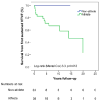Exercise increases age-related penetrance and arrhythmic risk in arrhythmogenic right ventricular dysplasia/cardiomyopathy-associated desmosomal mutation carriers
- PMID: 23871885
- PMCID: PMC3809992
- DOI: 10.1016/j.jacc.2013.06.033
Exercise increases age-related penetrance and arrhythmic risk in arrhythmogenic right ventricular dysplasia/cardiomyopathy-associated desmosomal mutation carriers
Abstract
Objectives: This study sought to determine how exercise influences penetrance of arrhythmogenic right ventricular dysplasia/cardiomyopathy (ARVD/C) among patients with desmosomal mutations.
Background: Although animal models and anecdotal evidence suggest that exercise is a risk factor for ARVD/C, there have been no systematic human studies.
Methods: Eighty-seven carriers (46 male; mean age, 44 ± 18 years) were interviewed about regular physical activity from 10 years of age. The relationship of exercise with sustained ventricular arrhythmia (ventricular tachycardia/ventricular fibrillation [VT/VF]), stage C heart failure (HF), and meeting diagnostic criteria for ARVD/C (2010 Revised Task Force Criteria [TFC]) was studied.
Results: Symptoms developed in endurance athletes (N = 56) at a younger age (30.1 ± 13.0 years vs. 40.6 ± 21.1 years, p = 0.05); they were more likely to meet TFC at last follow-up (82% vs. 35%, p < 0.001) and have a lower lifetime survival free of VT/VF (p = 0.013) and HF (p = 0.004). Compared with those who did the least exercise per year (lowest quartile) before presentation, those in the second (odds ratio [OR]: 6.64, p = 0.013), third (OR: 16.7, p = 0.001), and top (OR: 25.3, p < 0.0001) quartiles were increasingly likely to meet TFC. Among 61 individuals who did not present with VT/VF, the 13 subjects experiencing a first VT/VF event over a mean follow-up of 8.4 ± 6.7 years were all endurance athletes (p = 0.002). Survival from a first VT/VF event was lowest among those who exercised most (top quartile) both before (p = 0.036) and after (p = 0.005) clinical presentation. Among individuals in the top quartile, a reduction in exercise decreased VT/VF risk (p = 0.04).
Conclusions: Endurance exercise and frequent exercise increase the risk of VT/VF, HF, and ARVD/C in desmosomal mutation carriers. These findings support exercise restriction for these patients.
Keywords: (stage C) heart failure; 2010 Revised Task Force Criteria; ARVD/C; CI; ECG; HF; ICD; IQR; OR; RV; TFC; VT/VF; arrhythmogenic right ventricular dysplasia; arrhythmogenic right ventricular dysplasia/cardiomyopathy; cardiomyopathy; confidence interval; electrocardiogram; exercise; heart failure; implantable cardioverter-defibrillator; interquartile range; odds ratio; penetrance; right ventricular; ventricular arrhythmias; ventricular tachycardia/ventricular fibrillation.
Copyright © 2013 American College of Cardiology Foundation. Published by Elsevier Inc. All rights reserved.
Conflict of interest statement
Figures







Similar articles
-
Incremental value of cardiac magnetic resonance imaging in arrhythmic risk stratification of arrhythmogenic right ventricular dysplasia/cardiomyopathy-associated desmosomal mutation carriers.J Am Coll Cardiol. 2013 Nov 5;62(19):1761-9. doi: 10.1016/j.jacc.2012.11.087. Epub 2013 Jun 27. J Am Coll Cardiol. 2013. PMID: 23810894 Free PMC article.
-
Safety of American Heart Association-recommended minimum exercise for desmosomal mutation carriers.Heart Rhythm. 2016 Jan;13(1):199-207. doi: 10.1016/j.hrthm.2015.08.035. Epub 2015 Aug 29. Heart Rhythm. 2016. PMID: 26321091
-
Exercise has a disproportionate role in the pathogenesis of arrhythmogenic right ventricular dysplasia/cardiomyopathy in patients without desmosomal mutations.J Am Heart Assoc. 2014 Dec;3(6):e001471. doi: 10.1161/JAHA.114.001471. J Am Heart Assoc. 2014. PMID: 25516436 Free PMC article.
-
Current and state of the art on the electrophysiologic characteristics and catheter ablation of arrhythmogenic right ventricular dysplasia/cardiomyopathy.J Cardiol. 2015 Jun;65(6):441-50. doi: 10.1016/j.jjcc.2014.12.023. Epub 2015 Mar 25. J Cardiol. 2015. PMID: 25818480 Review.
-
Arrhythmogenic right ventricular dysplasia/cardiomyopathy (ARVD/C): a review of molecular and clinical literature.J Genet Couns. 2012 Aug;21(4):494-504. doi: 10.1007/s10897-012-9497-7. Epub 2012 Mar 17. J Genet Couns. 2012. PMID: 22426942 Review.
Cited by
-
Brazilian Guideline for Exercise Testing in Children and Adolescents - 2024.Arq Bras Cardiol. 2024 Sep 16;121(8):e20240525. doi: 10.36660/abc.20240525. Arq Bras Cardiol. 2024. PMID: 39292116 Free PMC article. English, Portuguese.
-
Exercise Dose in Clinical Practice.Circulation. 2016 Jun 7;133(23):2297-313. doi: 10.1161/CIRCULATIONAHA.116.018093. Circulation. 2016. PMID: 27267537 Free PMC article. Review.
-
Sudden Cardiac Death in Athletes: From the Basics to the Practical Work-Up.Medicina (Kaunas). 2021 Feb 14;57(2):168. doi: 10.3390/medicina57020168. Medicina (Kaunas). 2021. PMID: 33673000 Free PMC article. Review.
-
Lifestyle physical activity and rapid-rate non-sustained ventricular tachycardia in arrhythmogenic cardiomyopathy.Heart. 2023 Jun 14;109(13):992-999. doi: 10.1136/heartjnl-2022-321824. Heart. 2023. PMID: 36849235 Free PMC article.
-
Sport Participation in Patients with Implantable Cardioverter-Defibrillators.Curr Treat Options Cardiovasc Med. 2019 Nov 14;21(11):66. doi: 10.1007/s11936-019-0772-x. Curr Treat Options Cardiovasc Med. 2019. PMID: 31728782 Review.
References
-
- Marcus F, Fontaine G, Guiraudon G, et al. Right ventricular dysplasia: a report of 24 adult cases. Circulation. 1982;65:384–98. - PubMed
-
- Fontaine G. Arrhythmogenic right ventricular dysplasia. Curr Opin Cardiol. 1995;10:16–20. - PubMed
-
- Basso C, Corrado D, Marcus FI, Nava A, Thiene G. Arrhythmogenic right ventricular cardiomyopathy. Lancet. 2009;373:1289–1300. - PubMed
-
- Dalal D, Nasir K, Bomma C, et al. Arrhythmogenic right ventricular dysplasia. Circulation. 2005;112:3823–32. - PubMed
-
- Sen-Chowdhry S, Morgan RD, Chambers JC, McKenna WJ. Arrhythmogenic cardiomyopathy: etiology, diagnosis, and treatment. Annu Rev Med. 2010;61:233–53. - PubMed
Publication types
MeSH terms
Grants and funding
LinkOut - more resources
Full Text Sources
Other Literature Sources
Medical
Research Materials
Miscellaneous

